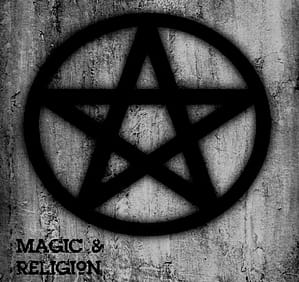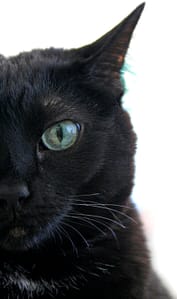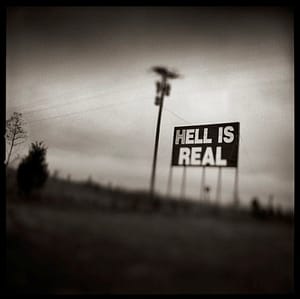Afraid? You will be… Halloween, Hell Houses, Magic & Religion.
“Our fascination with fear is a curious one, we’re addicted to the exhilaration of fear but only if we know we’re safe. From rollercoasters through to haunted houses, some of us subject ourselves to extreme situations for a quick thrill but some terror is all too real…”
And so autumn is upon us once more, and with the wind that rustles the leaves comes the season of Celtic (Halloween) and catholic celebrations (Al Saints Day), and let’s not forget the big roaring fires of bonfire night sparked from the ancient tradition of burning animal bones (bon fire) to ward off evil spirits. These days most of us settle for the burning of wood and other materials that we’d have a hard time convincing our fascist ‘refuse technicians’ to collect, but the symbology remains the same.
So, how much exactly do we know about these old traditions?
Well, Halloween owes its name to ALL HALLOWS EVE which precedes ALL SAINTS DAY (1st November), a naturally Christian celebration yet the practices of Halloween are Pagan in their origin. This paradoxical merger came to be many years later since the church denounced Pagans as satanic worshipers; “when you come into the land which the LORD your God is giving you, you shall not learn to follow the abominations of those nations.” No, Halloween has its roots deeply entrenched in the Celts of pre-medieval Europe who divided each year into two halves; the light and the dark half. Samhain (summer end) marked the end of summer and thus the harvest season. The ancient Celts believed that the 31st of October was the day when the veil, dividing the dead and the living, dissolved ‘bringing home’ evil spirits who could only be placated with bribes of food in exchange for immunity from a terrible curse (trick or treat). Some Celts would attempt to scare off the evil spirits by lighting hilltop fires that included the bones of animals (in a sacrificial gesture), placing skulls carved out of vegetables (jack-o-lantern) in strategic places and donning costumes in an attempt to emulate the spirits and go ‘unnoticed’.
Even in modern times, satanic worshipers believe that Halloween is the night when the Prince of Darkness himself returns to earth in order to collect and convert the souls of man. These are just some of the reasons why the church found pagan practices abhorrent and sought a global mass conversion to Christianity. It is believed this took place in the 7th century when the Pantheon of Rome was wrested from the ‘barbarians’ by the church and renamed the Church of The Blessed Virgin and all Martyrs thus going from worshiping All Gods (the Greek word for Pan-theon) to All Saints. It then moved the day that honoured all hallowed saints from the 13th May to the 1st of November to coincide with Samhain; All Hallows Eve (31st October). The church adopted some of the pagan practices in its quest to convert the ‘barbarians’ to Catholicism. Even ‘trick or treating’ became tolerated by the church; costumed children would knock on doors offering to fast for departed souls in exchange for money or an offering.
There was however one pagan practice that was not dissolved in the world’s conversion to Christianity; witchcraft. A witch (from the Anglo-Saxon word Wicca) was somebody who worshipped the deities of nature and collected living talismans and symbols through which they obtained dark powers. Legend has it that the broomstick (a representation of the male organ) was the vehicle upon which the witches flew great distances, in reality, they often dabbled with all sorts of drugs and potions which means those ‘trips’ could have been construed as flight.
 The Celts and the Egyptians also believed that the symbolic black cat possessed magical powers. Legend has it that the goddess of Wicca, Diana, turned into a black cat to commit incest with her brother. In all, witchcraft was seen as the worshipping of the devil as opposed to God and thus witches were persecuted for centuries. “Thou shall not suffer a witch to live” (Ex 22:18). Not unlike fox hunting on Boxing Day, witch hunting became a national pastime during the witching season.
The Celts and the Egyptians also believed that the symbolic black cat possessed magical powers. Legend has it that the goddess of Wicca, Diana, turned into a black cat to commit incest with her brother. In all, witchcraft was seen as the worshipping of the devil as opposed to God and thus witches were persecuted for centuries. “Thou shall not suffer a witch to live” (Ex 22:18). Not unlike fox hunting on Boxing Day, witch hunting became a national pastime during the witching season.
Naturally, books and films have sought to capitalise on the mystical elements of witchcraft but none more so than Harry Potter which for millions is seen as a piece of fictional fun but for some is a sinister rebranding of darker themes, such as demonic possession and Satanism. This is born out of passages from the book that refer to the evil character Voldermort who ‘possesses’ the soul of a young girl. In reality, Satanic worshipping sparked mass moral panic in eighties America (and then the rest of the world) where it was believed that the vast proliferation of satanic cults were leading to an increase of prostitution, drug abuse, murder, sexual abuse, pornography, as well as a vast array of disturbing acts (such as necrophilia and cannibalism). The torture of young children was also considered necessary in order to program them to observe a life of devil worship. This led to governments around the world stepping up their policies regarding child abuse investigations which in turn forced cults to revise their strategy and recruit people of standing, such as police officers and politicians.
Today, orange, black and red (the devil’s colours) come together primarily once a year, in the form of a carved pumpkin, on a day when children are given the opportunity to ‘dress up’ and terrorise the neighbourhood whilst most adults flirt with the concept of fear by watching scary movies and visiting old relics in the dead of night in the hope of scaring themselves silly.
Our fascination with fear is a curious one, we’re addicted to the exhilaration of fear but only if we know we’re safe. From rollercoasters through to haunted houses, we’ll do whatever it takes for a quick fix of adrenaline. I should know because I’m one of those junkies as evidenced by my one and only trip to the entertainment capitol of the north, otherwise known as Blackpool. It was a week day and, unsurprisingly, not a very sunny day which meant that the ‘pleasure beach’ was relatively empty. Of all the attractions, we kept on passing one which had a cavernous looking hole for a door outside of which was a wall mounted monitor projecting grainy night vision images of a group of people running and screaming from an unknown entity. For those not familiar with this type of ‘attraction’, it works on the basic premise of charging guests an entry fee to be guided down steps and into some artificial catacomb where the slogan alone is enough to strike the fear of God in most; “don’t touch them and they won’t touch you”!
Oddly enough, like a child drawn to the ubiquitous yet fairly innocuous ghost train, it was this very phrase that caught our attention and, after procrastinating for a few more minutes, we finally decided to brave it. Lucky for me (or not), the attraction wasn’t particularly busy which meant that instead of a group of people, it was just me and my friend, alone in the dark, able to see only but a few feet in front of us, deep in the belly of an ‘attraction’ whose sole purpose was to scare the be geezers out of us. Well, it worked! There were only so many times I could be startled by nerve wrenching screeches, accosted by blood oozing zombies and rattled by chainsaw-wielding psychopaths with disfigured faces before I wanted out of that place. Although, in hindsight, I have to wonder which part I hated the most, running from rooms kitted out with special effects and actors dripping (literally) in makeup or running screaming like a schoolgirl out of the exit doors (at the end of the experience) and into a strategically placed themed diner where patrons sipped drinks whilst enjoying the look of utter terror on the faces of those exiting the attraction.
It may not come as much of a surprise to you that some devout Catholics in North America are adopting the very same tactics to scare sinners out of sinning. ‘Hell Houses’ are normal looking buildings but with a twist; each of the rooms is kitted out to feature a sin; such as abortion, homosexuality, alcoholism, drug abuse, pre marital sex, abortion and, more controversially, a scene from the Columbine High School massacre (in the wrongful belief that Christians were being targeted for murder). The ‘exhibits’ tend to be ‘staged’ in October (to capitalise on the witching season) and, not unlike my experience, would-be sinners are treated to a collection of gruesome and horrifying scenes depicting sin and its consequences. Those who accept Christ will be saved and those who don’t will be damned to hell. What’s that all about? I chose to go down into the catacombs because the perverse side of me wanted a quick and temporary ‘thrill’. Those who ‘choose’ the path of ‘righteousness’ do so because they have a belief, it should not be necessary to administer such shock therapy to keep them on the straight and narrow. Then again, the other controversy surrounding hell houses is that they aren’t necessarily designed for ‘believers’ but more for ‘non believers’ who are deceived into thinking that the ‘attraction’ is a ‘traditional’ ghost house rather than an evangelical journey. This practice has also drawn criticism from some who believe the process of teaching by instilling fear into children is nothing short of child abuse. This is all somewhat ironic since, on the one hand, we have people brain washed into finding religion whilst, on the other, there are some who just wanted opportunity to freely practice it.
of sinning. ‘Hell Houses’ are normal looking buildings but with a twist; each of the rooms is kitted out to feature a sin; such as abortion, homosexuality, alcoholism, drug abuse, pre marital sex, abortion and, more controversially, a scene from the Columbine High School massacre (in the wrongful belief that Christians were being targeted for murder). The ‘exhibits’ tend to be ‘staged’ in October (to capitalise on the witching season) and, not unlike my experience, would-be sinners are treated to a collection of gruesome and horrifying scenes depicting sin and its consequences. Those who accept Christ will be saved and those who don’t will be damned to hell. What’s that all about? I chose to go down into the catacombs because the perverse side of me wanted a quick and temporary ‘thrill’. Those who ‘choose’ the path of ‘righteousness’ do so because they have a belief, it should not be necessary to administer such shock therapy to keep them on the straight and narrow. Then again, the other controversy surrounding hell houses is that they aren’t necessarily designed for ‘believers’ but more for ‘non believers’ who are deceived into thinking that the ‘attraction’ is a ‘traditional’ ghost house rather than an evangelical journey. This practice has also drawn criticism from some who believe the process of teaching by instilling fear into children is nothing short of child abuse. This is all somewhat ironic since, on the one hand, we have people brain washed into finding religion whilst, on the other, there are some who just wanted opportunity to freely practice it.
This is so of Robert Catesby who, along with thousands of other Catholics, simply wanted the right to practice his religion. Eh? What do you mean you’ve never heard of Mr Catesby? He was the man behind one of the most infamous and subversive government plots of all time. The foiling of this plot is still celebrated today, on the 5th November.
It took Catesby and Guy Fawkes a year to hatch the plan to blow up parliament and kill the king but a tip off, in the form of a letter, meant that their dastardly plan was foiled. Catesby died in a shoot out in Staffordshire whilst Fawkes was hung (by his neck), drawn (had his innards pulled out) and quartered (cut into four pieces), all before a public audience. And whilst he was not burned on a bonfire, his guts were as his head was speared onto a parliament house spike. That was the price of treason. Thereon, Londoners lit fires in the street to celebrate the fact that the king was saved.
Today, more than 400 years later, we celebrate bonfire night in pretty much the same way. Well, at least all without the hung, drawn and quartered bit. We’d much rather burn effigies instead. Remember, remember the 5th November; the day when we tortured and executed one man and his accomplices, ultimately, because they were deprived the right to practice their religion as they saw fit.
Can you imagine that happening in England today?
Leave a Reply